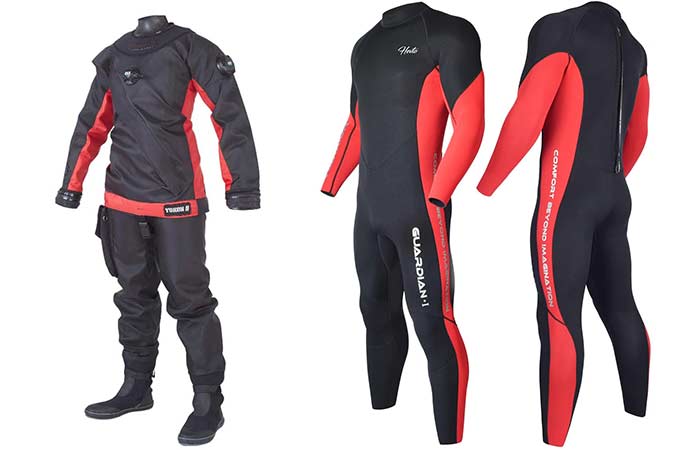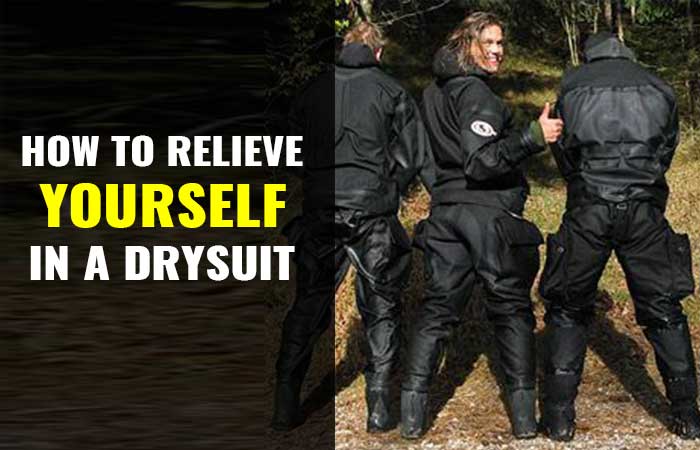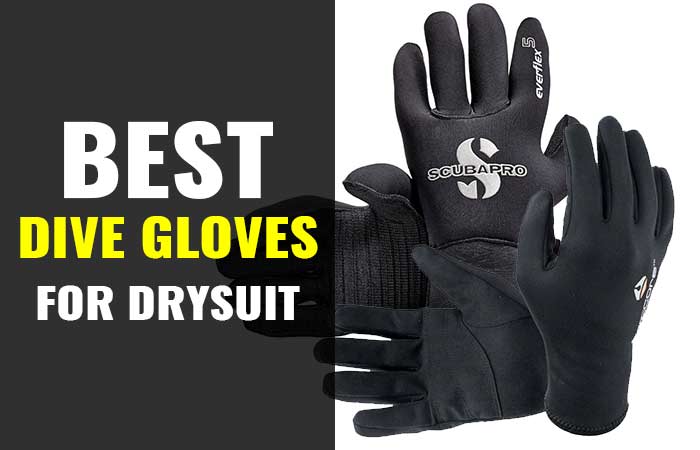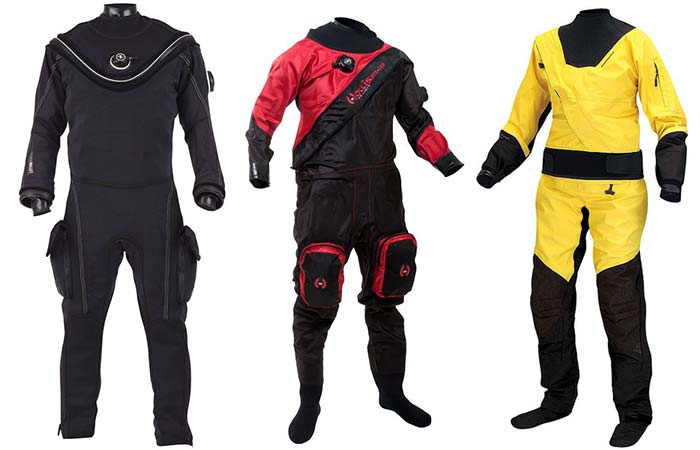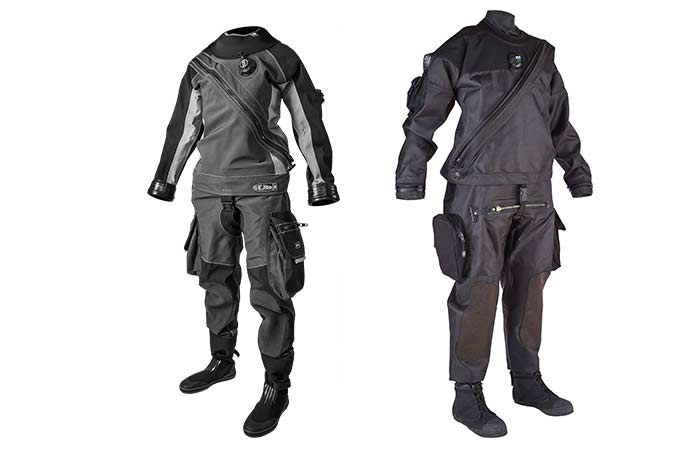Best Sailing Drysuits
Drysuits, as suggested by their name, are meant to keep you dry and warm when in or on the water. This is in opposition to wetsuits which keep you warm but wet. The suitability of drysuits to sailing is based on the conditions you’re exposed to when sailing.
First, you’re above the water and exposed to the wind. This means that you need to have warm clothing as opposed to thin ones. Secondly, you’re exposed to occasional sprays of water as the boat is hit by the waves. If water gets to your skin, it’ll do lots of damage in terms of cooling your body. This can get quite uncomfortable and may lead to hypothermia.
In choosing the best drysuit for your sailing activities, choose one that has the right thickness, is easy to put on and take off, easy to wash and made of high-quality materials. Considering these and other aspects, we have rounded up 7 of the best wetsuits for sailors to try out.
Crewsaver Atacama Sport Drysuit Front Zip + Undersuit

First up is the Crewsaver Atacama Sport Drysuit which packs lots of cleverly thought-out features to make it a must for any sailor. It comes with an undersuit to add warmth to the drysuit when you’re out on the boat and in harsh conditions.
With this drysuit, you enjoy a large range of motion which is handy when struggling against the waves on the water. Besides sailing, you can use is for jet skiing as well as kayaking given the features it’s packed with. You won’t worry about getting stuck anywhere since it is made with very little hanging items from the drysuit.
Pros
- The drysuit has an undergarment to increase the warmth for the wearer.
- Has a larger range of motion allowing for easier maneuvering. This is due to the articulated legs and arms.
- Has a slim profile to allow for easy moving in cramped places like the cabin of a boat.
- No hanging materials that can get stuck on the cabin of the boat.
- You can use the drysuits for other sports besides sailing. This makes it quite handy.
- Has a good fitting thanks to adjustable internal braces, elasticated waist and articulated arms and legs.
- You won’t sweat underneath the drysuit thanks to the 3 layers of fully breathable fabric all over the drysuit and Glideskin neoprene on the neck and wrist seals.
- It comes with removable braces with reinforced knees and seat for longevity.
- Has a D ring attachment point for attachment to lines and other items.
- It has a high quality YKK Aquaseal zip.
Cons
- It can be a little difficult to get in due to the position of the zipper for some users.
I’d recommend this drysuit for any water sports that require lots of movement given how good it is.
GUL Dartmouth Eclip Zip Drysuit Black with Free Undersuit

Another very impressive drysuit you can take to the waters in your sailing activities is the GUL Dartmouth Eclip. It comes with three layers of materials which are breathable and warm to use. You thus won’t get all sweaty when competing in your sailboat though you will remain warm.
The roomy drysuit allows for thicker undergarments if the included undersuit isn’t enough in cold weather. The heat taped seams ensure that no water leaks into the suit for a warm and dry experience. The seals at the wrist and neck are made of soft neoprene material to provide a watertight yet very comfortable seal.
Pros
- Has 3 layers of waterproof and breathable material for complete dryness inside but without sweating.
- The body panels are contoured to reduce bulk, snagging and windage.
- Articulated arms and legs for flexibility when moving around in your sport.
- Heat taped seams that are waterproof and provide protection from the water and wind.
- The seals at the neck and wrists are made of soft neoprene material for comfort while providing a watertight seal.
- It has hard wearing knee and seat panels which make it durable and comfortable on tough surfaces.
- Has a YKK waterproof zipper to keep the inside warm and dry and also allow easy wearing and putting off the drysuit.
- Given the roomy nature of the drysuit, you can add many layers of clothing for the cold waters.
Cons
- It can get uncomfortably warm in very hot areas.
This is one of the best drysuits for above-water activities such as skiing and sailing in cold areas.
Palm Men’s Atom Back Zip Kayak Drysuit + CON Zip Flame
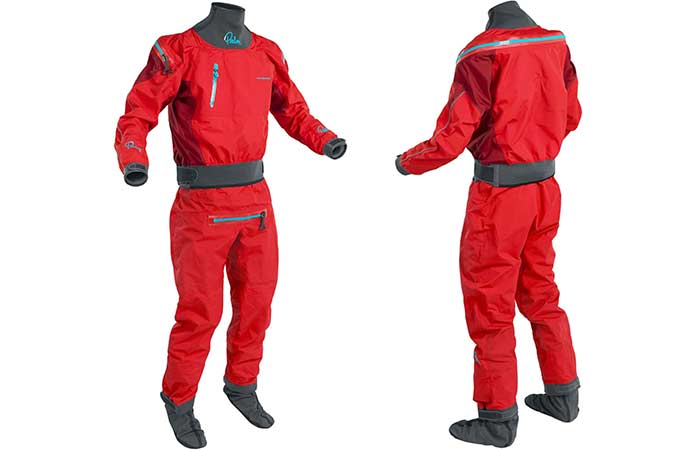
Next on the list is the Palm Atom drysuit which has four layers of material for the best warmth. Having used one, I’d recommend that you use this one in cold weather conditions as it can quickly get warm in warm weather. The four layers are all waterproof and of a high quality making sure that you don’t feel weighed down by the drysuit when sailing or kayaking.
You have a long list of adjustments from the size of the waist which can be adjusted with a Velcro waistband and others. The seals at the neck and arms are made of soft neoprene material to make them both comfortable and watertight. This ensures you have a warm and dry suit even when it’s raining or wet outside.
Pros
- Comes with 4 layers of materials to keep the inside warm and dry.
- Had high quality YKK Aquaseal relief and entry zippers that are long lasting and reliable.
- Has a Velcro adjustable waistband for the best fit.
- The seams are positioned to prevent their exposure to wear and tear. This ensures their longevity.
- It fits well without any excesses making it one of the best when it comes to maneuvering on the boat in tough conditions.
Cons
- It can’t be used in warm conditions as the four layers of material get warm quite fast.
This is an easy choice for anyone competing in sailing games in cold weather as it provides one of the best flexibilities and warmth in a drysuit.
Gill Dinghy Drysuit

The Gill Dinghy Drysuit is from the makers of previous sailing drysuits which have gained favor among sailors for their high quality and simplicity. With this one, you get four layers of materials which ensures that the drysuit is warm and waterproof at all times. The four layers, however, are breathable meaning you won’t be sweaty inside.
You also have options to get the right fit for the body as it comes with an elasticated waist and elastic braces with the latter allowing you to get a watertight seal around the hands. We also noted that it has a water repellent film which makes the water slide off your suit. This ensures that you don’t carry any water into the cabin.
Pros
- Glideskin cuff and collar seals ensure a custom fit for the user.
- It comes with fabric socks for warmth in the feet. The socks also last quite long thanks to the materials used to make them.
- Elasticated waist for a firm and comfortable fit.
- Extra durability from the reinforced seat and knees.
- A high quality YKK zipper is also sturdy and reliable.
- The internally adjustable braces provide a comfortable fit for different users using the same drysuit.
- Has a cargo pocket on the thigh with a low profile for carrying extra items.
- Has 4 layers of waterproof and breathable fabric for warmth and comfort.
Cons
- It gets warm in warm to hot tropic weather hence not the best for these conditions.
We love how easy it is to enter and get out of this drysuit. The four layers provide one of the warmest experiences in a drysuit even in harsh conditions with rain and high winds.
GUL Code Zero Stretch U-Zip Drysuit
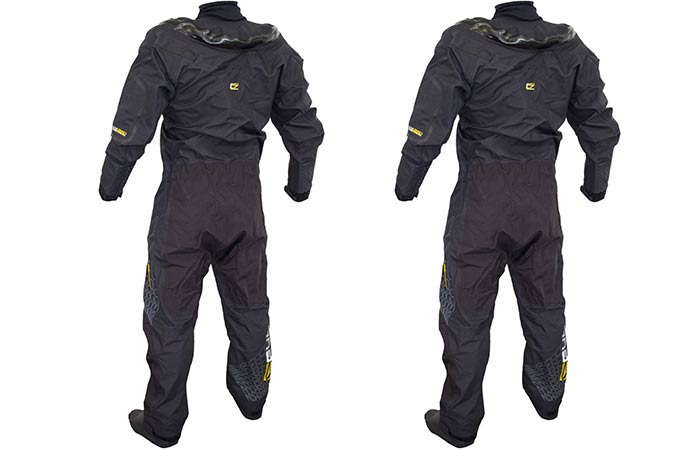
Another entry from GUL which shows that they make quality items is the Code Zero Stretch drysuit with contoured body panels for comfort and great fitting. Like all the drysuits that perform well in a sailing situation, its materials are waterproof and can stretch with a 2/2 mechanical stretch factor. The breathable material also ensures that you get a great feeling without sweating.
Other important aspects about this drysuit are the many ways in which you can adjust it for a better fit and high level of flexibility. For example, you can adjust the tightness of the waist and cuffs too. The drysuit also has articulated arms, knees and the seat which makes it durable but still very comfortable to use even for long periods of time.
Pros
- It has a 2/2 mechanical stretch which ensures the freedom to move about without feeling restricted by the drysuit.
- The material used on the drysuit is both breathable and waterproof. As such, you’ll have a dry inside but won’t sweat as there’s enough air circulation.
- The seams are also waterproof thanks to the taping technology used to make them.
- The arms, knees and seat are articulated to add comfort and flexibility.
- It has a YKK zipper with a low profile to provide the best experience getting in and out of the suit.
- The body panels are countered to reduce windage, bulk and snagging.
- You also get a water-resistant sleeve pocket with a zipper of its own for extra items.
- Cuffs and ankles are also adjustable for the perfect fit.
- Comes with latex socks to keep the feet warm and dry.
Cons
- The latex used can be reactive to some users who have an allergic reaction to latex.
This drysuit is easy to use and doesn’t have too much to distract you from the quality of the features added. It just works.
BR1 Core Sailing Trousers
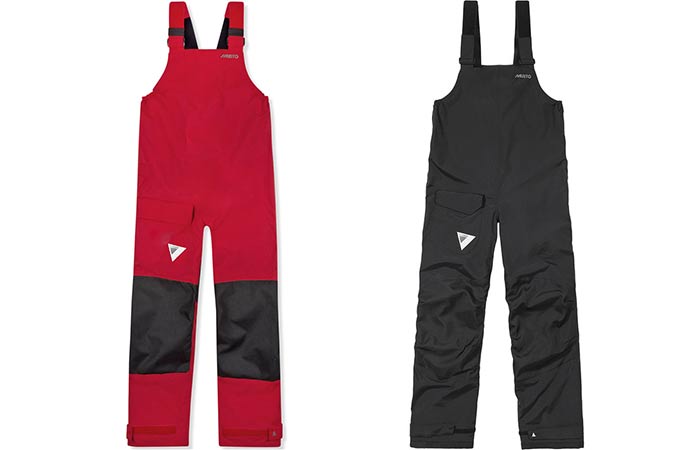
The BR1 Core Sailing Trousers are a one-of-a-kind type of drysuit as they adopt the shape of overalls while serving as a drysuit. They cover the legs and the core while exposing the arms for sailing in hot tropical waters. It’s made of waterproof material that will protect your body from the water and the wind when sailing.
If you need protection for the arms, you can add a drysuit for the upper body when it gets cold. We found it to be one of the best for competing in sailing competitions in warm tropical conditions where there’s a lot of wind and heat as well. Besides that, it looks cool too given the red and black theme.
Pros
- Breathable and waterproof material at 2 layers for the best protection against water and wind.
- Faster drying due to the shell hang loop.
- Had a thigh patch pocket with a drain hole for carrying some extras.
- The knees are articulated for protection and flexibility.
- Durable knee pads due to the overlaid knee panels.
- Has a gusset panel which increases the durability of the drysuit.
- The seams are taped and sewn for the best protection from the water.
- Fits well due to the elasticated braces, underarms, waist and back.
- It comes with a hook and loop fastener adjustable ankles which keep out the rain and water sprays.
Cons
- It doesn’t protect the arms.
This type of drysuit is for those in the tropics or summers on the waters given the design that has no arms. You can, however, pair it with some other drysuit to cover the arms.
Prolimit Nordic Sup U-Zip Drysuit

Last on our list is the Prolimit Nordic Sup drysuit. It has 4 layers of material to make it warm in cold and windy conditions. If you’re worried about being too hot and sweaty under the drysuit, you’ll be pleased to know that the wetsuit is fully breathable and won’t become uncomfortable.
One most notable feature about this drysuit is that it has a flex panel at the back to increase the comfort and flexibility you have when carrying out stretching activities. In other drysuits, the suit becomes sticky and restrictive but not with this one.
Pros
- 4 layers of material that’s waterproof and breathable for protection and comfort.
- There’s a flex panel at the back of the drysuit to allow for easy movement.
- It has a neck made of neoprene which makes it flexible and comfortable.
- The internal taping used prevents the entry of water into the drysuit.
Cons
- Made only for the cold and windy weather due to the four layers of materials.
If you’re sailing in cold weather conditions, this is one of the drysuits to consider for your next trip.
Any one of these drysuits comes in various sizes. Make sure you get the size that best fits your body to remain comfortable, warm and flexibility. The right drysuit should serve you for several seasons if kept well.
Buyer’s guide
If you’re looking for a drysuit for your next sailing trip, you should consider the following aspects:
The fabric the drysuit is made of
Most drysuits will come with either 3 or 4 layers of waterproof and breathable fabric to keep you in a comfortable state as you sail. They also allow moisture to escape which prevents sweating which can be quite uncomfortable. As sailing entails lots of activities while exposed to winds and water, you should go with the fabric that best brings out these traits.
The thicker the fabric used, the higher the amount of heat it can preserve. If you will be sailing in cold waters, go for thicker materials and undergarments. If you’re in the tropics, less materials and undergarments will suit you better.
Feet coverage
The drysuit may come with booties (boots), socks or with nothing on the feet. You should always consider drysuits and wetsuits with protection for the feet for the best experience. These parts of the feet can be made of latex material or the same material the drysuit is made of. Whatever the material used, make sure the feet are well-covered.
You can also buy your own socks or booties to go with your drysuit although that’s an extra cost on your end.
Internal suspension system
The drysuit, usually in one piece, can weigh down your shoulders if it’s not given a suspension system. Most manufacturers include a kind of suspender system to keep the weight distributed by the body to avoid getting tired.
You won’t, however, find this feature in all drysuits. Luckily, there are other ways to distribute the weight of the drysuit around the body to ensure it’s comfortable.
The seals and seams
To keep the water out of the drysuits, the seals at the hands, ankles and neck need to be watertight. They are usually made of soft and stretchy materials such as neoprene or latex. They should, however, not be uncomfortable such that wearing the drysuit is a pain. Make sure you get a drysuit with adjustable seals for the best experience.
The seams are the regions where two or more pieces of the drysuit material meet. These should either be taped, glued or stitched to provide a watertight seal for the drysuit. The more the methods used to seal the seams, the better.
Zippers
You should go for waterproof zipper that is flexible enough to bend and twist without losing the waterproof qualities. YKK AquaSeal zippers are usually the best for such cases.
With these aspects in mind, you can find the drysuit you need for sailing.
More on Drysuits

